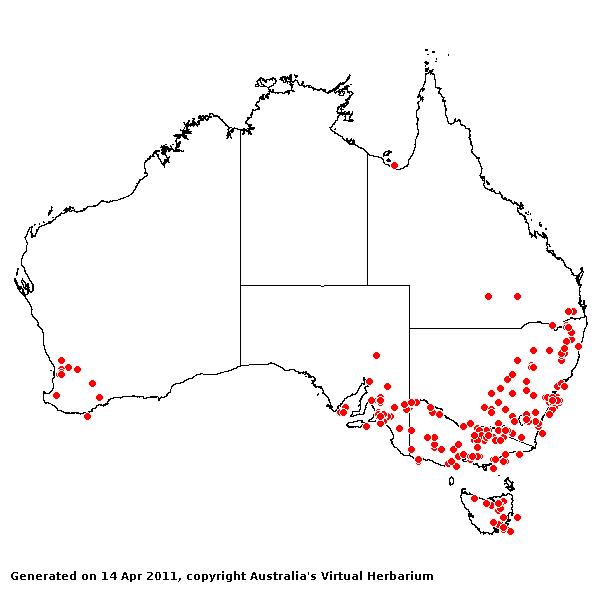Digitaria sanguinalis* (L.) Scop. Fl. Carn. ed. 2, 1: 52 (1772).
Classification. (GPWG 2001) : Subfamily Panicoideae. Paniceae.
Basionym and/or Replacement Name: Panicum sanguinale L., Sp. Pl. 1: 57 (1753).
Type of Basionym or Protologue Information: ST: Van Royen s.n. [Panicum 6], Cultivated at Leiden (L). see Hitchcock, 1908, Cotnrb. U.S. Natl. Herb. 12: 117; Henrard, 1950, Digitaria Monograph pp. 647–650, (Ill. of spikelet p. 649). ST: H. U. "8 sanguinale", (LINN-80.31). H.U. is Hortus Upsalensis; this specimen was accepted as the type by Munro 1862, Proc. Linn. Soc. Bot. 6: 37, and by A.S. Hitchcock. Contr. U.S. Natl. Herb. 12: 117 (1908). ST: [Clayton 451], (LINN-80.32). Clayton 451 or "457" are not in the Clayton Herbarium at BM.
Key references (books and floras): [1878] G.Bentham, Flora Australiensis 7 (469 as Panicum sanguinale), [1952] C.A.Gardner, Flora of Western Australia 1 Gramineae (227), [2002] D.Sharp & B.K.Simon, AusGrass, Grasses of Australia, [2002] J.Wheeler, N.Marchant & M.Lewington, Flora of the South West (412), [2006] J.Jessop, G.R.M.Dashorst, F.M.James, Grasses of South Australia (443), [2008] S.W.L.Jacobs, R.D.B.Walley & D.J.B.Wheeler, Grasses of New South Wales (220).
Illustrations: [1952] C.A.Gardner, Flora of Western Australia 1 Gramineae (228, Pl. 67), [1984] N.T.Burbidge. rev. S.W.L.Jacobs, Australian Grasses (113), [2006] J.Jessop, G.R.M.Dashorst, F.M.James, Grasses of South Australia (443, Fig. 374), [2008] S.W.L.Jacobs, R.D.B.Whalley & D.J.B.Wheeler, Grasses of New South Wales, 4th edn (220).
Habit. Annual. Stolons absent. Culms decumbent or prostrate, 10–60 cm tall, 2–8 -noded. Mid-culm internodes glabrous. Mid-culm nodes glabrous or bearded. Lateral branches sparsely branched. Leaf-sheaths hairy. Leaf-sheath auricles absent, or present. Ligule an eciliate membrane, 1–2 mm long. Leaf-blades flat, 3–17 cm long, 2–14 mm wide. Leaf-blade surface smooth or scabrous, indumented.
Inflorescence. Inflorescence digitate or subdigitate, with racemose branches. Racemes 4–10, 4–18 cm long. Central inflorescence axis 0.5–3 cm long.
Spikelets. Spikelets pedicelled, 2 in the cluster. Fertile spikelets 2-flowered, the lower floret barren (rarely male), the upper fertile, comprising 1 basal sterile florets, comprising 1 fertile floret(s), without rachilla extension, elliptic, dorsally compressed, 2.5–3.3 mm long. Rhachilla internodes brief up to lowest fertile floret.
Glumes. Glumes thinner than fertile lemma. Upper glume lanceolate, 1.2–1.6 mm long, membranous, 3 -nerved. Upper glume surface glabrous or indumented. Florets. Basal sterile florets 1, barren, without significant palea. Lemma of lower sterile floret 100 % of length of spikelet, membranous, 7 -nerved.
Fertile lemma 2.4–3.3 mm long, without keel. Lemma apex muticous. Lodicules present. Anthers 3.
Continental Distribution: Europe, Africa, Temperate Asia, Tropical Asia, Australasia, North America, South America, and Antarctica.
Australian Distribution: Western Australia, South Australia, Queensland, New South Wales, Victoria, Tasmania, Lord Howe.
Western Australia: Drummond. South Australia: Gairdner-Torrens Basin, Flinders Ranges, Eastern, Eyre Peninsula, Northern Lofty, Murray, Yorke Peninsula, Southern Lofty, South-eastern. Queensland: Darling Downs, Warrego, Maranoa. New South Wales: North Coast, Central Coast, South Coast, Northern Tablelands, Central Tablelands, Southern Tablelands, North-Western Slopes, Central-Western Slopes, South-Western Slopes, South-Western Plains, South Far Western Plains. Victoria: East Gippsland, Eastern Highlands, Gippsland Plain, Grampians, Lowan Mallee, Midlands, Murray Mallee, Otway Plain, Riverina, Volcanic Plain, Wannon, Wimmera. Tasmania: North East, Midlands, East Coast.
Notes. Closely related to D. ciliaris.
Introduced. In dry sclerophyll forests, tropical and subtropical sub-humid woodlands, temperate sub-humid woodlands, sub-alpine sub-humid woodlands, semi-arid shrub woodlands, and eucalypt shrublands. A common weed of temperate areas, preferring loamy disturbed habitats. Flowers mostly Jan.-Apr.









